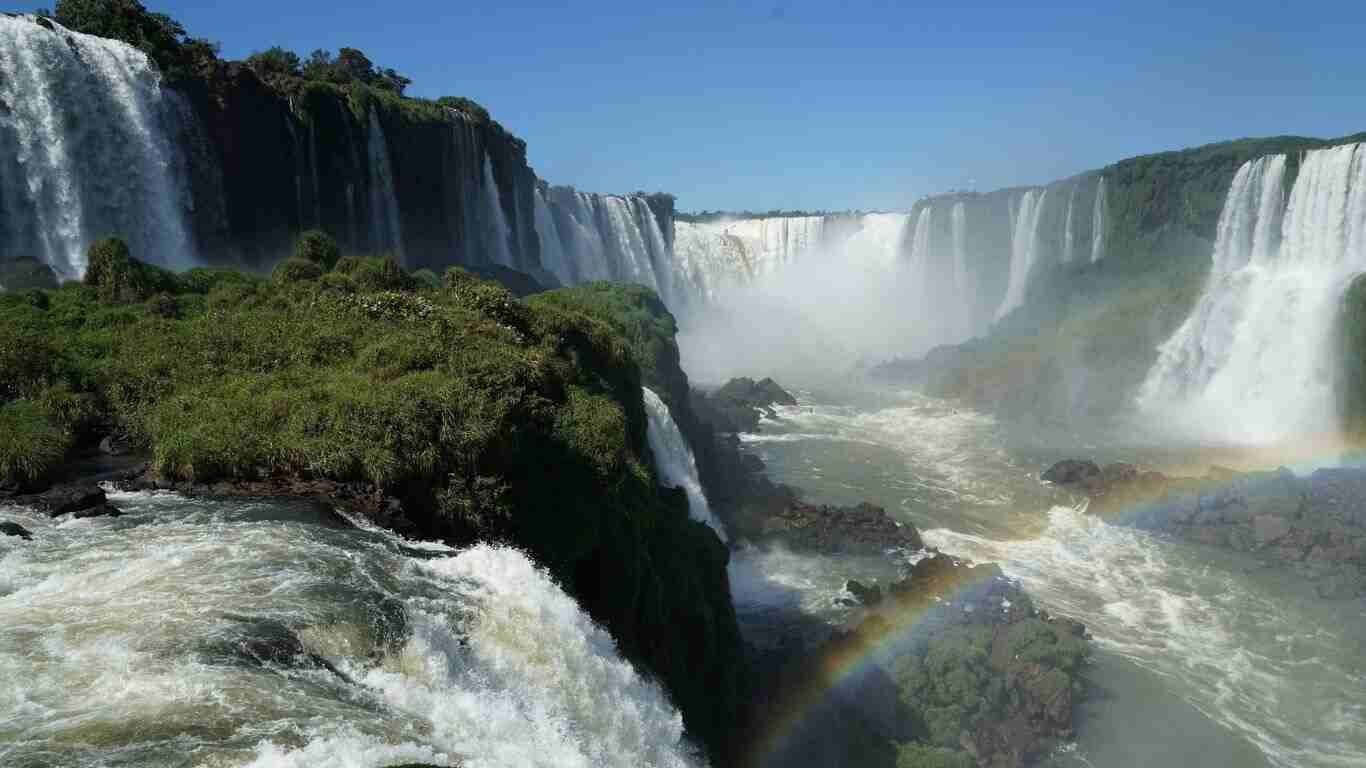
Table of Contents
ToggleOverview of Iguazu Waterfall
One of nature’s most spectacular wonders, the Iguazu Waterfall, spans the border between Argentina and Brazil. This breathtaking waterfall system is a sight to behold, spanning around 2.7 kilometers (1.7 miles) and featuring approximately 275 separate falls. Tucked away in the verdant grounds of Iguazu National Park, a UNESCO World Heritage Site known for its breathtaking scenery and abundant biodiversity, is the Iguazu Waterfall. The falls provide visitors with an amazing experience and are a monument to the strength and beauty of nature.
The Argentine side and the Brazilian side are the two primary viewing locations for the Iguazu Waterfall. Different viewpoints and experiences of the falls are offered by each side. The Brazilian side offers panoramic views that capture the majesty of the entire waterfall system, while the Argentine side offers long walking trails and up-close views, including the well-known Devil’s Throat (Garganta del Diablo). When combined, these vantage locations offer a thorough and engrossing perspective of the Iguazu Waterfall.
Geographical Location
Where Is Iguazu Waterfall Located?
Situated along the Iguazu River on the border between Brazil and Argentina, the Iguazu Waterfall is one of the world’s most breathtaking natural sights. This magnificent waterfall system is located inside the Iguazu National Park, which crosses the border between the two countries, and is around 2.7 kilometers (1.7 miles) long. There are two major cities from which the Iguazu Waterfall is accessible: Foz do Iguaçu in Brazil and Puerto Iguazú in Argentina. Every city offers distinctive amenities and entry points for tourists eager to witness this remarkable natural marvel.
Accessibility and Transportation
The Iguazu Waterfall is easily accessible because it is close to important transportation hubs. Cataratas del Iguazú International Airport (Argentina) or Foz do Iguaçu International Airport (Brazil) are the usual destinations for international flights. Travelers can take a variety of modes of transportation from these airports, such as shuttle buses, taxis, and rental automobiles. It is simple to get to the park entrances because of the well-developed road and public transportation networks.
A lot of tour companies also provide shuttle services and planned trips from major cities in Argentina and Brazil, guaranteeing that guests can easily reach the Iguazu Waterfall. Some businesses arrange beautiful helicopter excursions that offer breathtaking aerial views of the falls and the surrounding area for those seeking a more daring approach.
History and Discovery
Discovery of Iguazu Waterfall
Spanish adventurer Álvar Núñez Cabeza de Vaca made the first written record of the Iguazu Waterfall in 1541. A broader expedition that explored South America’s interior included Cabeza de Vaca. His visit to the Iguazu Waterfall, which revealed the falls’ majesty and scope to European viewers for the first time, was a turning point in the European exploration of the New World. His thorough descriptions and drawings made the Iguazu Waterfall widely known around the world.
Historical Significance
In addition to being a popular destination for scientists and explorers, the Iguazu Waterfall has great cultural value. The falls have been treasured as a sacred spot by the indigenous Guaraní people for millennia, as told in their myths and stories. Numerous scientific studies have been conducted on the falls, looking at their hydrology, geological development, and the variety of ecosystems they support. The Iguazu Waterfall’s reputation as a globally recognized natural wonder is a result of its rich historical background and cultural significance.
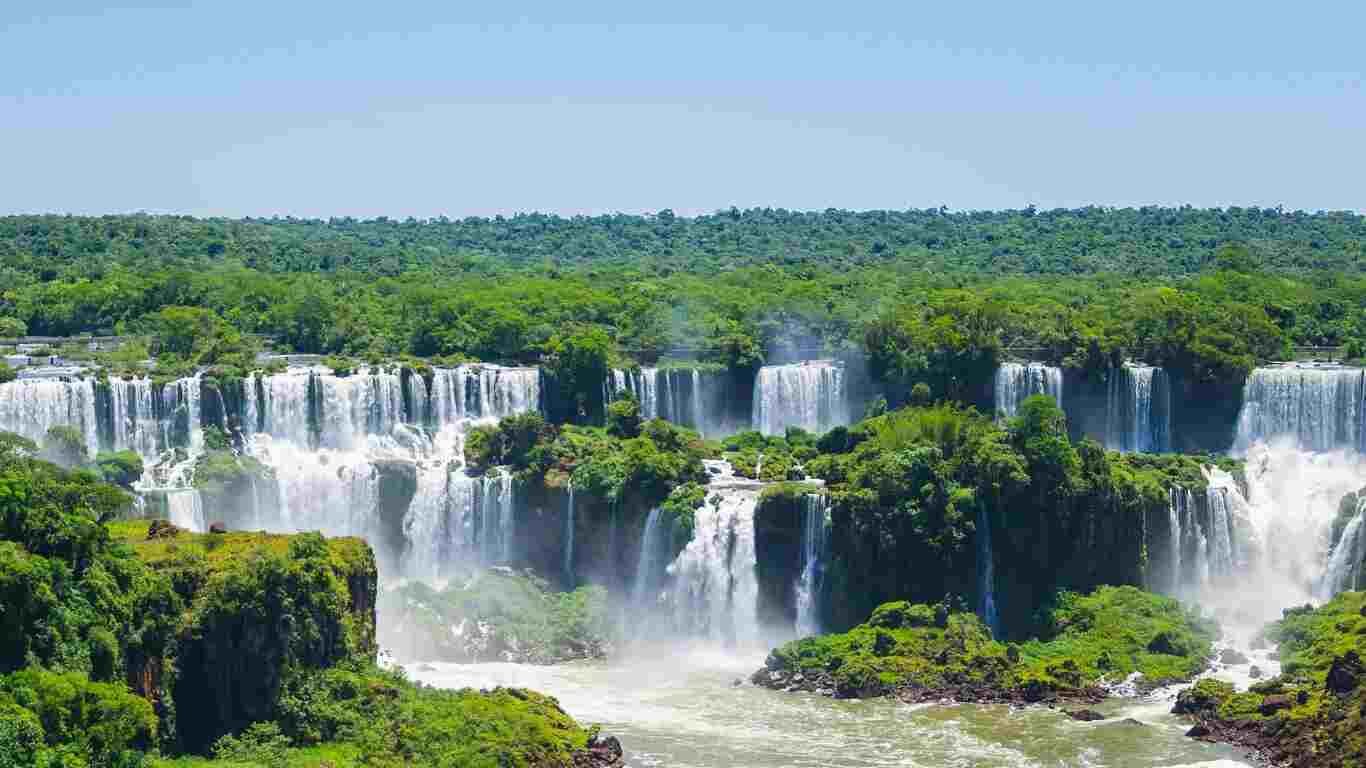
Weather Information
Best Time to Visit Iguazu Waterfall
The dry season (April through September) is the ideal time to see the Iguazu Waterfall. It’s good weather with less humidity and rain throughout these months, which makes it more comfortable to explore the park and stroll the paths. In addition to offering excellent vision and clean skies for photography, the dry season significantly improves the overall Iguazu Waterfall experience.
Seasonal Weather Patterns
The Iguazu Waterfall region has a subtropical environment all year round, with high humidity and copious amounts of rainfall. Frequent, intense rains during the wet season, which lasts from October to March, enhance water flow and produce more striking waterfalls. Higher humidity and sporadic flooding are also present during this time, which may have an impact on the accessibility and state of the trails. Those who intend to visit during the rainy season should make appropriate plans and be ready for these kinds of weather.
Best Viewing Spots
Top Viewpoints in Argentina
Several excellent viewing locations on the Argentine side of the Iguazu Waterfall provide breathtaking views of the falls. The most well-known vantage point, Devil’s Throat (Garganta del Diablo), offers an unmatched perspective of the most potent and dramatic portion of the falls. Visitors can experience the loud boom of the river and feel its incredible force from this observation point.
The Upper Circuit gives higher views of the falls and the surrounding rainforest, including the Devil’s Throat, while the Lower Circuit offers closer vistas and the chance to feel the spray of the cascades. Every viewpoint adds something different to the overall experience of the Iguazu Waterfall.
Top Viewpoints in Brazil
The Iguazu Waterfall’s Brazilian side is renowned for its expansive vistas that span the whole falls. You can take wide-angle photos along the main promenade on the Brazilian side, which offers magnificent views. A broad perspective of the falls and the verdant forests surrounding them is available to visitors.
On the Brazilian side, there are also noteworthy vantage spots such as the observation decks, which provide distinct views and angles of the falls. Since the shifting light may produce breathtaking visual effects and accentuate the splendor of the Iguazu Waterfall, these locations are perfect for daytime excursions as well as sunset photography.
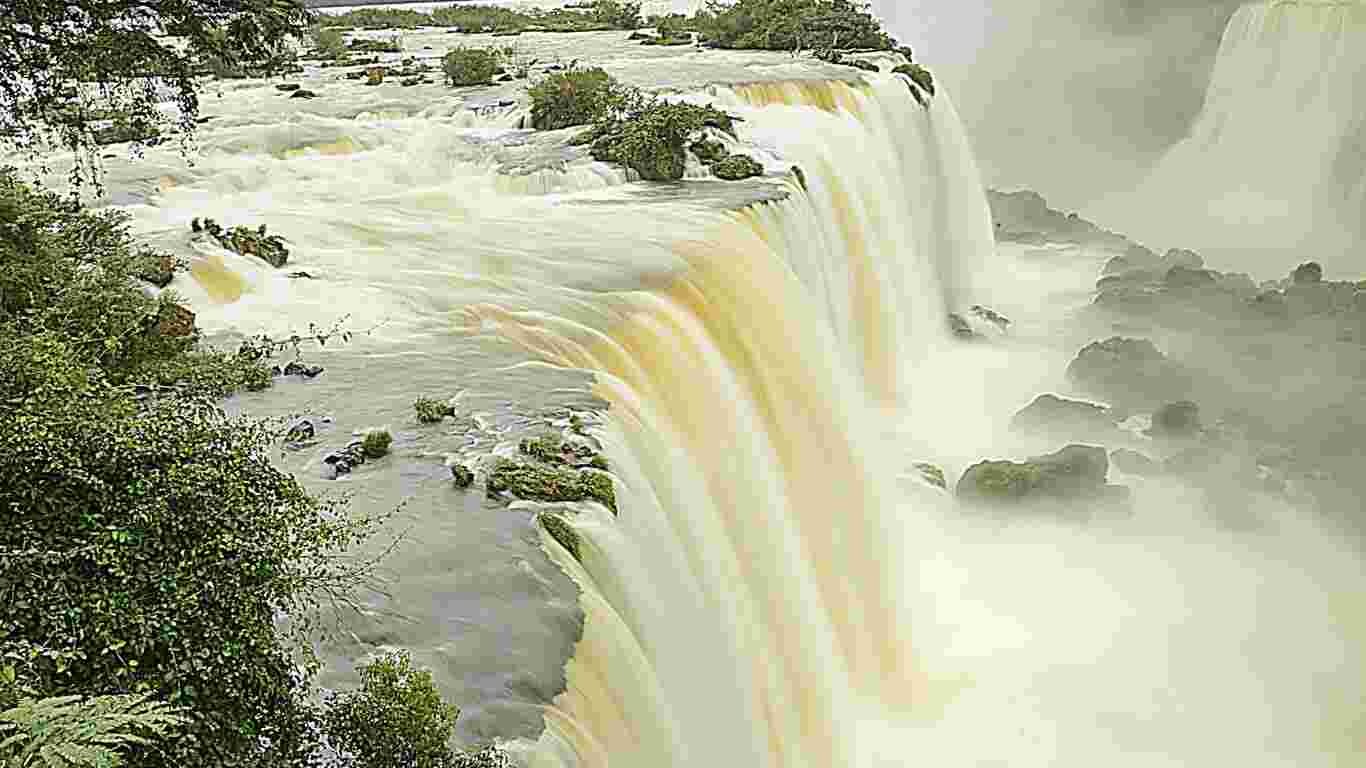
Walking Trails and Paths
Popular Trails on the Argentine Side
There is a network of well-kept walking trails offering a variety of perspectives and experiences on the Argentine side of the Iguazu Waterfall. The Upper Circuit route is a great place to see the falls from above because it provides superior vistas. Additionally, this trail offers expansive vistas of the nearby river system and rainforest.
Visitors can have up-close experiences with the mist and spray as well as immersive views of the waterfalls on the Lower Circuit route, which brings them closer to the water. For those looking for a more hands-on encounter with the falls, this trail is a favorite because it offers a number of picturesque overlooks and photo possibilities.
Trails on the Brazilian Side
The main route on the Brazilian side provides a long walking path with many of observation spots and overlooks. All ages and skill levels can enjoy this well-designed trail that offers a full view of the Iguazu Waterfall. The route is accessible and has amenities like panoramic vistas and raised walkways.
There are several walkways and viewing areas in addition to the main route that provide different angles of the falls and the surroundings. These pathways improve the overall visitor experience by offering chances for additional exploration.
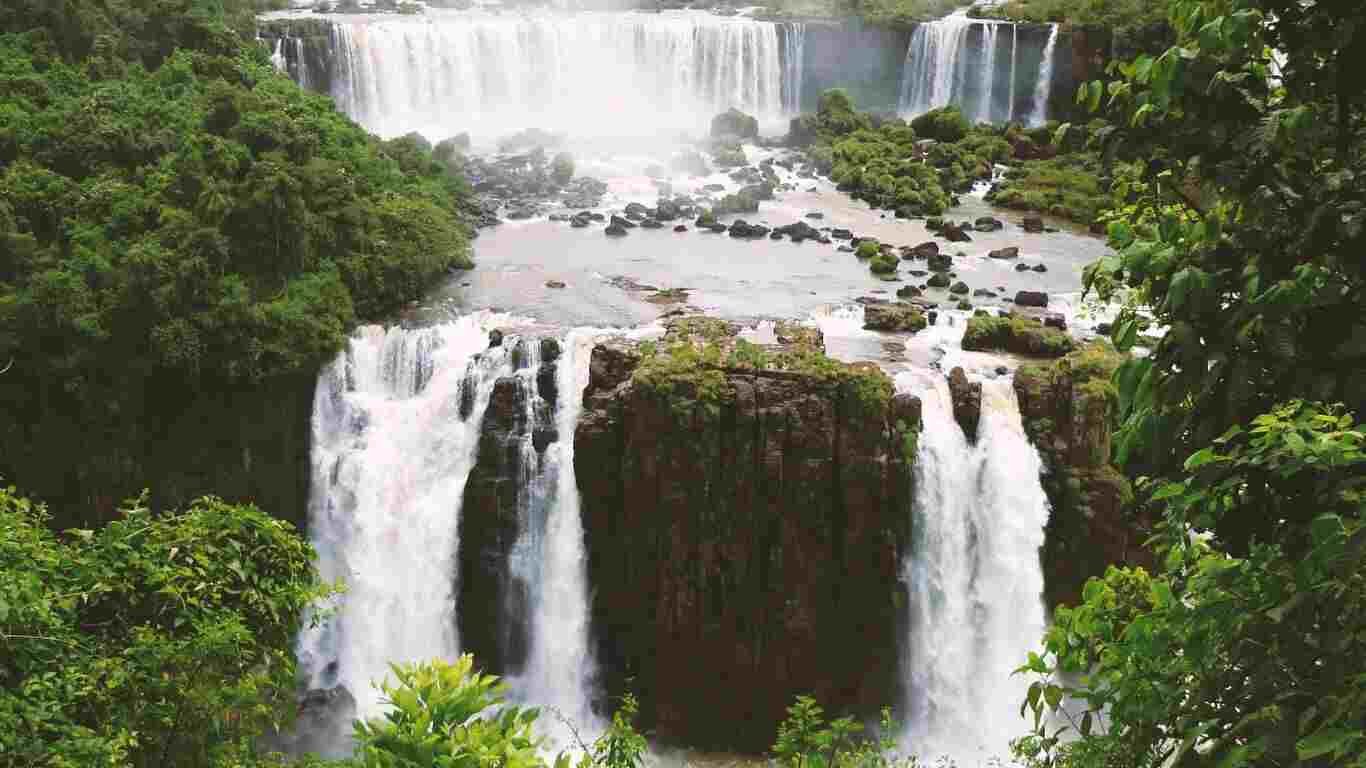
Wildlife and Flora
Fauna Around Iguazu Waterfall
Because of its high biodiversity, the region around the Iguazu Waterfall is a wildlife enthusiast’s paradise. Numerous animal species, including as coatis, capuchin monkeys, and howler monkeys, may be seen by visitors. Numerous different types of birds, including as hawks, parrots, and toucans, can be found in the lush jungle habitat. There are many of options for wildlife observation and photography near the Iguazu Waterfall thanks to the colorful and diverse animals.
Flora and Vegetation
The subtropical rainforest ecology around the Iguazu Waterfall is home to a diverse range of plant species, making the surrounding vegetation equally striking. Giant ferns, tall trees, and brilliant orchids are among the plants that give the park its lush, lively appearance. The Iguazu Waterfall area’s overall attractiveness is enhanced, and the local wildlife is supported by the rich vegetation.
Boat Tours and Water Activities
Boat Tours Close to the Falls
A well-liked method to see the Iguazu Waterfall from a different angle is through boat cruises. These trips bring guests up close to the falls so they can experience the force of the spray and the sound of the roaring water. The boat trips are intended to be exhilarating and safe, and the guides make sure that the experience is interesting and filled with knowledge about the falls.
Some operators provide specialty cruises that incorporate extras like snorkeling or ecotourism experiences in addition to standard boat tours. A thorough and full experience of the Iguazu Waterfall and its surroundings is offered by these trips.
Rafting and Adventure Activities
Beyond boat tours, the Iguazu Waterfall area provides a variety of activities for adventure seekers. Rafting trips offer an exhilarating experience as they navigate the rapids of the river. A thrilling element to the visit is added by zip-lining and other airborne sports, which provide unique views of the falls and the surrounding jungle. Through these exciting and dynamic adventure activities, guests may interact with the natural world in a whole new way.
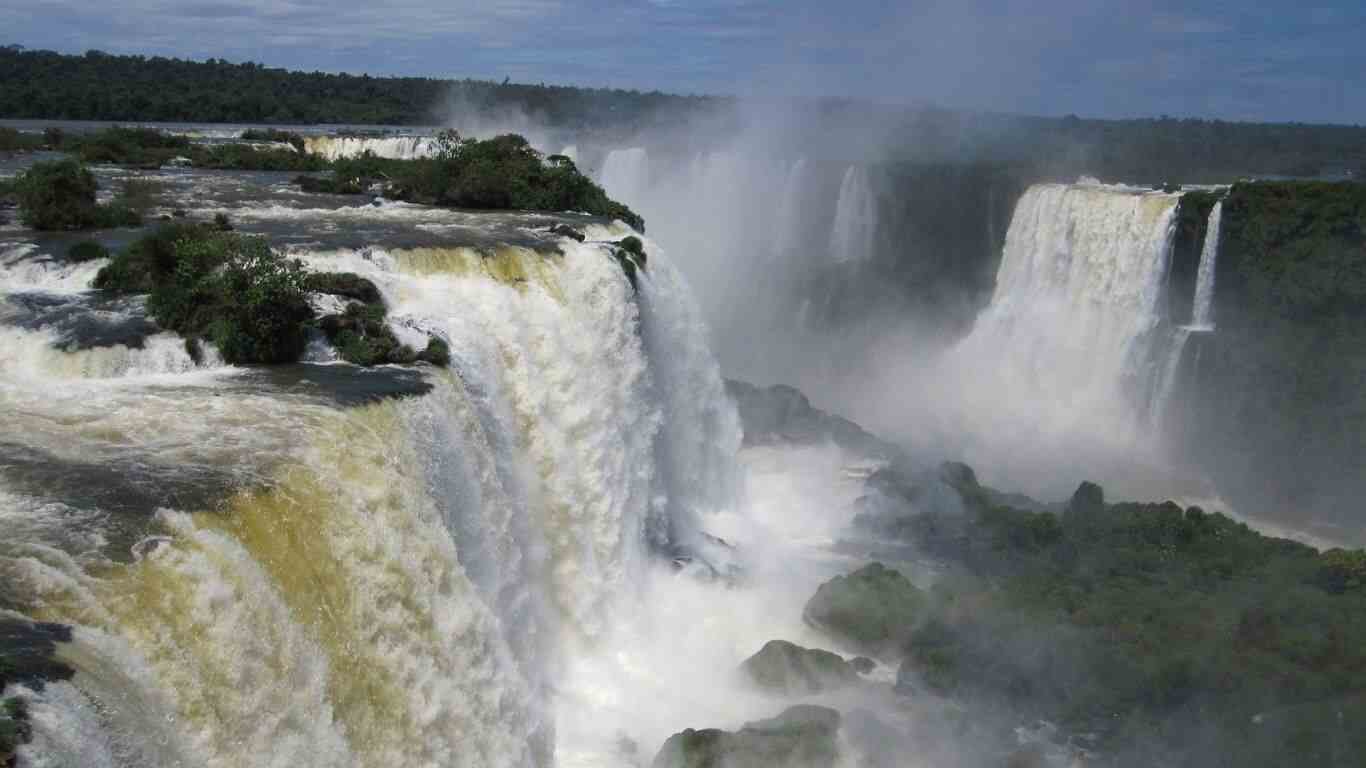
Visitor Center and Facilities
Facilities on the Argentine Side
There is a fully functional visitor center with a variety of amenities available for visitors on the Argentine side of the Iguazu Waterfall. The center has gift stores, dining options, and restrooms. To improve their experience at the falls, visitors can get help, maps, and informational displays. For those who are interested in learning more, the center also has informative exhibits about the geology, ecology, and history of the falls.
Facilities on the Brazilian Side
The tourist center on the Brazilian side has comparable services, such as dining options, gift shops, and restrooms. The center is made to meet the demands of visitors, offering convenience and comfort while they are there. The interactive exhibits and educational displays on the Brazilian side also emphasize the environmental and cultural value of the Iguazu Waterfall.
Guided Tours and Experiences
Guided Tours of the Falls
Both the Brazilian and Argentinean sides of the Iguazu Waterfall offer guided trips. These trips provide extensive background knowledge on the ecology, geology, and history of the falls. Aside from offering insightful commentary, well-informed guides enrich the visiting experience with fascinating anecdotes and facts about the falls. Customized guided tours can be tailored to accommodate a range of hobbies, such as photography, environmental education, and seeing wildlife.
Special Experiences and Activities
Apart from the conventional trips, the Iguazu Waterfall region provides unique experiences like helicopter tours, which offer amazing aerial views of the falls and the surroundings. There are special chances to see the falls from various perspectives during night visits and private tours. By offering tourists the chance to view the falls from novel and fascinating angles, these unique experiences give the trip a memorable and unique quality.
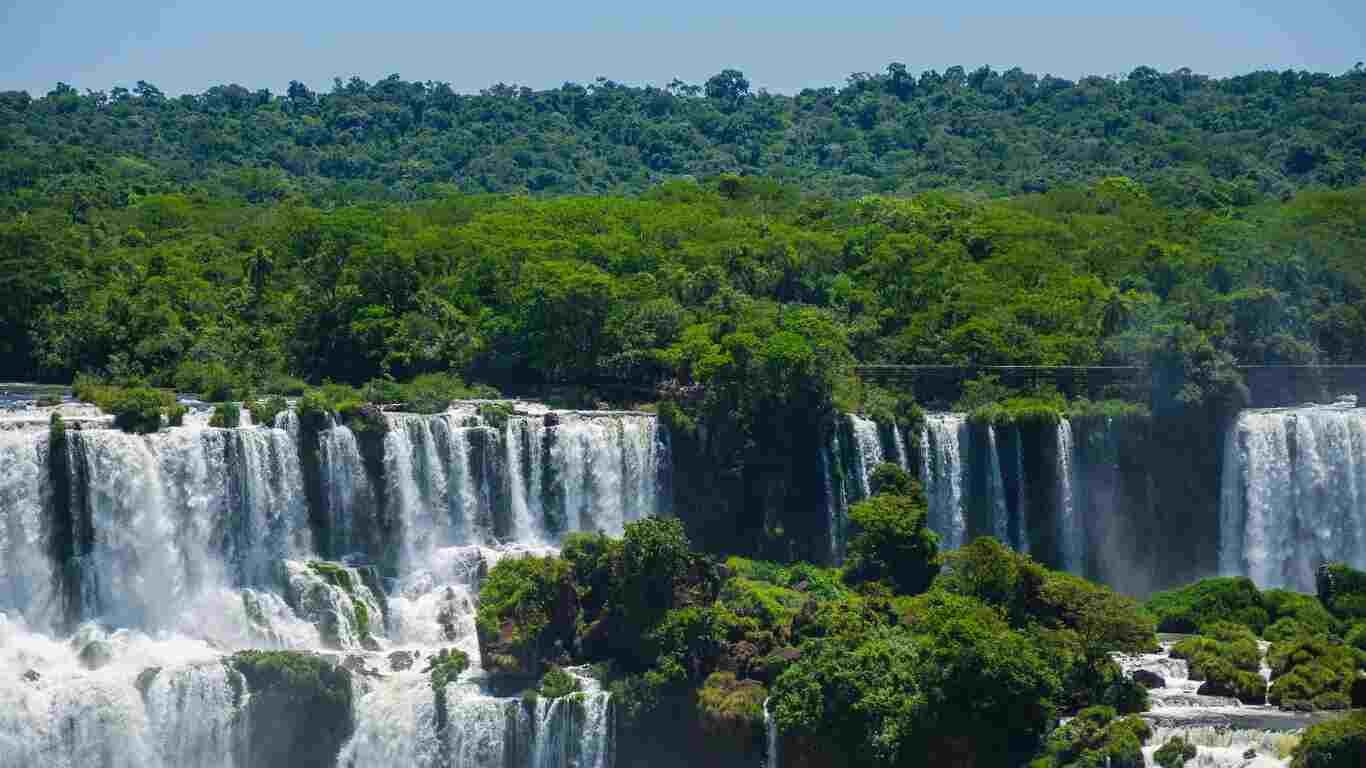
Photography Tips
Capturing the Best Views
Use a wide-angle lens to capture the entire breadth of the falls in order to get breathtaking pictures of the Iguazu Waterfall. The light in the early morning or late afternoon can produce stunning effects and bring out the colors in your images. Stability and clarity can be improved by using a tripod, particularly in low light or when taking long exposure photos. Furthermore, attempting various viewpoints and angles can aid in capturing the majesty and splendor of the falls.
Dealing with Mist and Spray
There is a lot of spray and mist from the Iguazu Waterfall, which can affect photos. Use a lens hood or waterproof cover to keep moisture out of your camera. Mist can be reduced and crisp, sharp photos can be obtained by using a fast shutter speed. Having lens cleaning wipes handy to remove any smudges or water stains can assist preserve image quality and guarantee that the breathtaking aspects of the falls are captured in your pictures.
Local Culture and Traditions
Cultural Significance
For generations, the native Guaraní people have honored the Iguazu Waterfall in their myths and stories, giving it great cultural value. The falls are revered, and local cultural customs are strongly influenced by their presence. A better understanding of the Iguazu Waterfall’s significance beyond its natural beauty is made possible by knowing its cultural context, which enhances the visiting experience.
Local Festivals and Events
Numerous festivals and activities are held all year long to honor the Iguazu Waterfall’s natural beauty and cultural legacy. These gatherings provide guests with an opportunity to interact with regional customs and traditions through traditional music, dance, and cultural acts. Taking part in or seeing these celebrations offers a deeper comprehension of the regional customs and imbues the trip with even more significance.
Accommodation and Dining Options
Where to Stay Near Iguazu Waterfall
There are a variety of lodging alternatives close to the Iguazu Waterfall, from opulent hotels to affordable hostels. Numerous hotels provide easy access to the park and breathtaking views of the falls. International hotel companies, boutique hotels, and environmentally conscious resorts are among the options. It is advised to reserve lodging in advance, particularly during the busiest travel seasons, to guarantee availability and guarantee the greatest possibilities for your visit.
Dining Options in the Area
There is a wide range of cuisine to choose from near the Iguazu Waterfall. There are many different types of restaurants in the park, ranging from fast snacks in the cafeterias to gourmet dining experiences with views of the rainforest. Along with foreign fare to accommodate a variety of palates, local specialties like Brazilian cuisine and Argentine steaks are offered. To enhance the entire experience of visiting the falls, check out the local eating scene.

Safety Induction
Guidelines for Visiting the Falls
When it comes to viewing the Iguazu Waterfall, safety comes first. When walking on trails that have been designated, visitors should use caution when in damp or slick conditions. To guarantee a secure and pleasurable stay, adherence to park rules and the guidance and instructions of park rangers is necessary. It is possible to prevent mishaps and guarantee a safe and secure experience when exploring the falls by adhering to designated pathways and respecting safety signs.
Emergency Services and Assistance
The Iguazu Waterfall has emergency services on both the Brazilian and Argentinean sides. In the event of an emergency, guests should call the numbers listed or speak with park personnel. Help is easily accessible in case assistance is needed, thanks to the presence of first aid stations and skilled professionals to support guests in need. All visitors to the falls are safer and more likely to be in good health when emergency services are available.
Key Attractions
Iconic Viewpoints of the Iguazu Waterfall
There are numerous famous vantage locations that highlight the spectacular grandeur of the Iguazu Waterfall. The Devil’s Throat, also known as the Garganta del Diablo, is one of the most well-known and is situated in Argentina. This strong portion of the falls is well-known for its thunderous boom and tremendous plunges, offering an incredibly breathtaking experience. A network of walkways and observation platforms provides visitors with unmatched views of this magnificent section of the Iguazu Waterfall.
The expansive promenade offering sweeping views of the complete waterfall system is located on the Brazilian side. From this vantage point, tourists can fully experience the Iguazu Waterfall’s grandeur and breadth, as well as the surrounding verdant rainforest. Photographers hoping to get the entire expanse of the falls in one frame will find that the wide vistas offered by this angle are perfect.
Adventure Activities and Interactive Experiences
The Iguazu Waterfall area provides a variety of adventure activities for those looking for a more hands-on experience. Visitors may feel the thrilling spray and get up close and personal with the overwhelming force of the cascading water thanks to boat trips that bring them close to the falls. With their distinct viewpoint of the falls, these tours are intended to be exhilarating but safe.
In addition, the park provides thrilling opportunities to interact with nature through activities like zip-lining and rafting. The Iguazu Waterfall is a site that appeals to thrill-seekers as well as nature lovers. Rafting excursions through the river’s rapids and zip-lining across the canopy provide exciting views and immersive experiences.
Conclusion - Why Tourist Place Iguazu Waterfall?
World-famous for its breathtaking natural beauty, abundant biodiversity, and cultural significance, the Iguazu Waterfall enthralls tourists. A renowned tourist destination, the falls provide a wide range of experiences and activities in addition to their enormous scale and force. The Iguazu Waterfall provides an amazing experience whether you’re looking for adventure, leisure, or a closer relationship with nature. Every tourist will leave with priceless memories of this amazing natural wonder because of its accessibility, plenty of services, and distinctive features.
